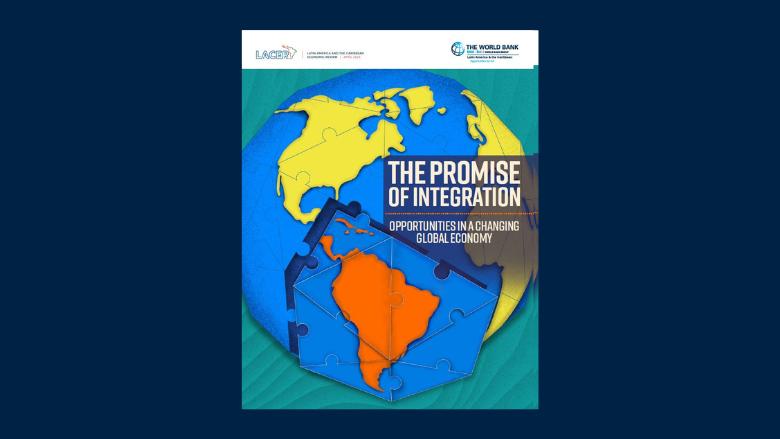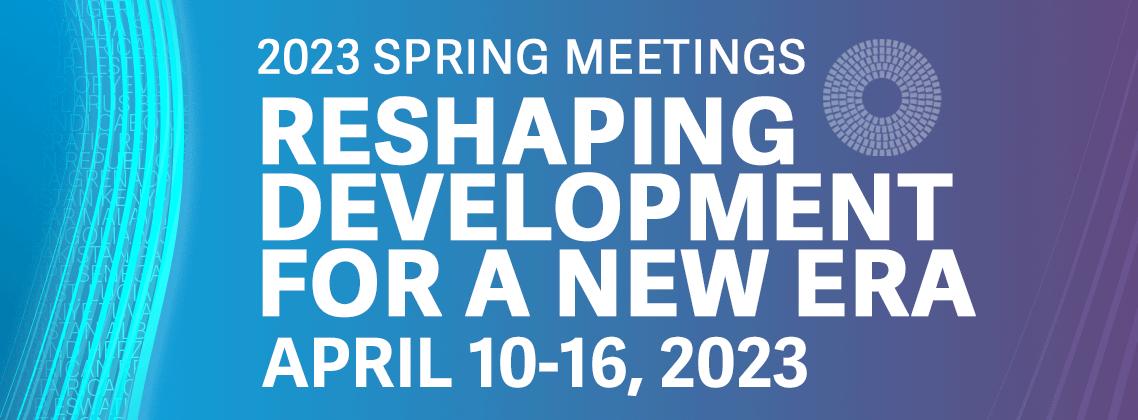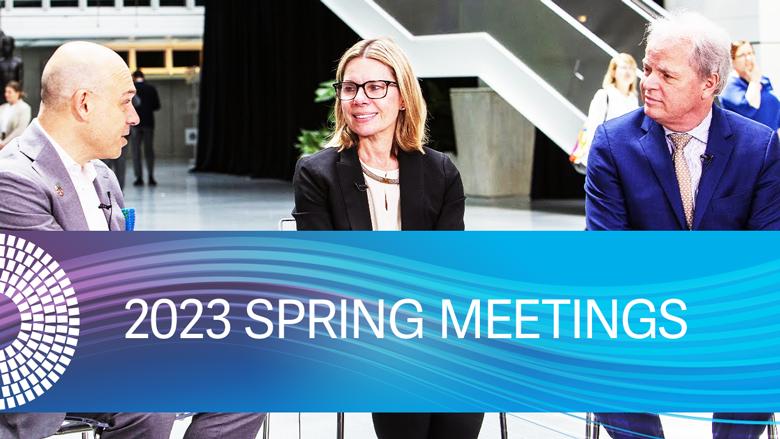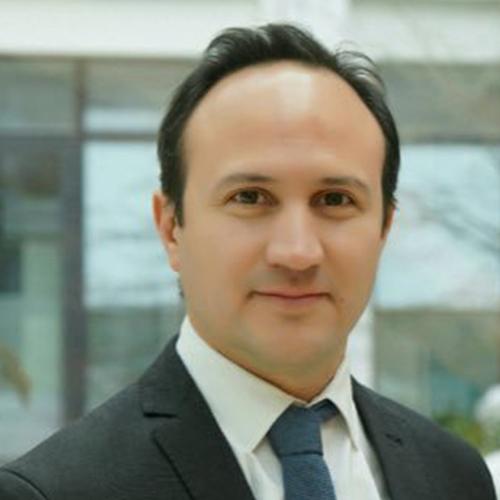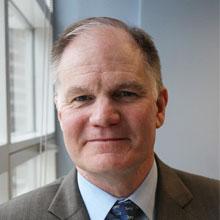[Gabriela Frías]
Hello, everybody, and welcome. Thank you for joining this conversation organized by the World Bank to discuss one of the challenges facing the economy in Latin America and the Caribbean.
The big question is how can greater integration into global trade networks help to develop the region? This morning, the Office of the Chief Economist of the World Bank presented the Regional Economic Report for Latin America and the Caribbean, which is published every year before the Spring Meetings. This report analyzes the outlook for growth in the region and analyzes key issues to do with economy and the development which affect policymakers and opinion leaders in the region. This year, the Economic Report analyzes the potential for integration and the opportunities inherent to a shifting global economy.
To discuss this today. I'm joined by Bill Maloney, who is the Chief Economist for Latin American Caribbean Region, the World Bank Maria Fernanda Garza, who is the Chair of the International Chamber of Commerce and Sebastián Nieto Parra, who's the Head of Latin America and the Caribbean Unit at the OECD Development Center. Thank you for joining us.
Bill, I'd like to start with you. The economic outlook presented today was not very encouraging. In fact, the outlook looks even worse than it did in 2022.
[William Maloney]
Sure. Good morning, Gabriela. Yes. Our forecast for 2023 is less optimistic than last year. We are expecting about 1.4% growth. That is due mainly to high interest rates in the advanced countries, lower growth rates in G7 countries in China, and a fall in the prices of raw materials around the globe. Those four factors are brutally affecting us. We are expecting a bit higher growth for the coming years, about 2.4%. But it is important to underline that these growth rates are more or less equal to what we had in 2010. So, we are going back to quite low growth rates which are not high enough to elevate poverty or alleviate social tensions.
[Gabriela Frías]
In addition to this, we're saying that we're the region that's going to exhibit the least growth this year.
[William Maloney]
Yes. If we compare where we are now in 2023 to where we were during the pandemic, for instance, we are the region that has grown the least in the world. On the optimistic side, we have had more success fighting inflation than, for instance, the OECD in general, we were better than Eastern Europe as well. This reflects. Mainly. the good handling of the problem, starting a year before, the Federal Reserve in the US, for instance, where countries in the region took actions very quickly and were very aggressive to guarantee that inflation expectations were not included in the salaries and starting a new inflationary cycle in the region.
[Gabriela Frías]
Now that you're talking about the Federal Reserve and what we've seen, I wanted to ask you to comment on the collapse in the banking sector in the United States and the general crisis of confidence and I wanted to ask you what you think is the effect of this recent collapse and obviously what happened with Credit Bank Suisse and how all this impacts the region. Do you think there's any resonance there?
[William Maloney]
The first thing that is important to underline here is that the direct connections between those banks and the banks in Latin America are not many, there are not many connections there. The probability of a direct contagion effect is very low. Nonetheless, we have elements in the dynamics, that is to say, the fall in the value of the bonds held by the banks. Well, that affects all of the banks in the world. I know that the superintendents of banks in the region are watching carefully what happens with the portfolios of the banks. It's something important, and we need to keep an eye open.
[Gabriela Frías]
Absolutely. Then, there's the issue of inflation, which is creating a difficult context, leading us to ask you about the recent decision taken by the OPEC+ Group to cut production when many people think this will lead to greater inflation. We're looking at what the oil majors are seeing, and how this will affect them. We have major importers and exporters of oil in our region.
[William Maloney]
Obviously, the increase of oil prices and fuel in China is not welcome, and it affects family budgets throughout the region, especially in the Caribbean and the non-exporting countries that you mentioned. Having said that, we still have a forecast of about 5% inflation for 2023, and Central Banks will reach their goals in 2024.
[Gabriela Frías]
Let me include another comment which has to do with the health sector. They've had to earmark major resources during the pandemic, and now with higher inflation and major subsidy programs to mitigate the effect of the pandemic, this is affecting more vulnerable groups. Let's talk a little bit about these factors.
[William Maloney]
What is the issue in particular?
[Gabriela Frías]
I mean, those factors that have to do with poverty and the OPEC+ decisions to cut production.
[William Maloney]
During the pandemic we had an increase in poverty throughout the region with the exception of Brazil, where we had more generous transferences than in the rest of the region. Leaving the crisis behind, what we saw was, first an increase in the prices of fuel and food products due to the war in Ukraine. This had an impact on inflation of the most vulnerable homes. We went back a little bit, but they are still important. As you have just said, the increase of oil prices will continue punishing these families. Looking at the region in general, poverty for this year is a bit above where we were in 2019. We lost about five years of progress in terms of poverty. But little by little, we are coming back to the levels that we had before.
[Gabriela Frías]
If we connect this to the other part of my question, COVID-19 and the recommendations made by the World Bank to continue tackling the challenges facing the healthcare systems in the region.
[William Maloney]
Yes. Two elements that are not only in Latin America, they are everywhere. But we had two challenges leaving the pandemic behind.
One is precisely the health systems. We learned where they are weak and where we have to work to make them stronger for the next pandemic or the next crisis that will affect us. We know this is going to happen. The region is not making many efforts to strengthen those systems.
The second challenge is precisely education. We lost more or less a year of schooling, which implies that we need to make important efforts for students who lost those years and ensure they’re not left behind. Especially because the students that had Internet, that had connection could continue with their education, whereas the poorest ones or the ones in more vulnerable families did not have this possibility. So, the effect extended the divisions in societies and inequalities. This is an important task as well.
[Gabriela Frías]
Now, this is the context in which we need to tackle the opportunities the World Bank talked about, such as integration. Now, this is something I'd like to start talking about with you. You're talking about two major opportunities for the region, aren't you?
[William Maloney]
Yes, we have two great opportunities for the region. The first one is precisely that countries like the US or Europe want to bring more of their value chains closer to their countries. Exactly. And governments in Latin America? Well, Latin America is next to the US. We are in the same time zone. In theory, we have an opportunity, a major opportunity to capture some of the links in value chains. We are going back to the challenges that we face in that regard. But the second opportunity is precisely in the green economy. That is to say that the region has the electric matrix that is the greenest one in the world. So, in theory, our exports should have a more desirable premium in the international markets. We are producing more green energy than any other region in the world. With green hydrogen, solar and other sources. We are very well positioned to export these sources of energy. We also have a lot of lithium and copper, which are important for new technologies, and we have an abundance of natural resources that can be used in terms of tourism or other things. We are very well positioned in terms of comparative advantages.
But this implies that we need to be very well integrated into the global economy to make use of the existing markets. We also need all of the technology that we don't have. We cannot invent everything in the region, so we need to have trade and foreign investments that bring technology. The focus of the report is precisely that we need to integrate more to make use of these opportunities.
[Gabriela Frías]
Within this approach towards a greater integration, we now have to look at where we're standing at the moment. According to the World Bank, we are integrating more slowly or almost disintegrating. There is a disintegration process underway. How would you describe that?
[William Maloney]
If we look at figures, for instance, regarding foreign direct investment in terms of billions of dollars, we have experienced more or less disinvestment or a fall of about 2 billion to 1 billion dollars in the last ten years. Whereas if we look at foreign trade as a percentage of the GDP, we have also seen a fall in the last ten years. That is to say, we are less integrated right now than we were ten or 15 years ago. This is exactly the opposite to where we should head if we want to make good use of our opportunities. The opportunities which we have discussed.
[Gabriela Frías]
Of course, this has been underscored by the effects of the pandemic on the value chain. Now we're talking near shoring and reshoring, aren't we?
[William Maloney]
Yes. We can see what is happening in Mexico very strongly. Many companies from everywhere in the world, especially China, that are setting foot in Mexico, but the contrary is happening in South America. For instance, we have seen a fall of about 10% in capital flows to the foreign capital flow of the region in the last ten years. We can see that Mexico is making good use of this opportunity but the rest of the region, not so much.
[Gabriela Frías]
Not so much, right. Bill, I want to open up the conversation to bring in Maria Fernanda because she represents the private sector and we'll also be bringing in Sebastián Nieto. Maria Fernanda, Bill has been talking about a specific context affecting the private sector. What have you been seeing over the last few months?
[Maria Fernanda Garza]
Basically we are seeing the opportunities that Bill has mentioned. The first is near shoring. Because this is such a volatile and uncertain environment like the ones companies are facing, it's very difficult for us to actually foresee the demand correctly. That is why today companies must be global but also local at the same time. This is exactly what we are observing. In other words, the globalization strategies and the near shoring strategies are coexisting. Companies are constantly assessing, doing arbitrage, and shortening the supply chains to better respond to changes in consumer demands through their local then supply which is near shoring or do it low-cost, although maybe the factories are very far away. So, this would be the global arena. Bill mentioned their rivalry between the US and China, creating disruption as well as some opportunities. Because of the proximity of our region with the larger North American market, probably China will do also other incursions in Latin America in 2023 in strategic areas like lithium mining. As well as Latin America, it's becoming more and more competitive vis-a-vis the rest of Asia in terms of labor costs because labor costs in China are increasing.
Another advantage in the region because of its proximity to the US, and you mentioned that very clearly, is the appeal of investments as we see is happening in Mexico. Truthfully, Mexico is being almost immune to that rivalry between China and the US. This is being tapped into by many companies.
The second opportunity we see is in mining and combating climate change. As Bill mentioned, Latin America is a very rich region in terms of minerals that are significant for the energy transition. More than half of the lithium in the world is within the region, what we call this lithium triangle between Bolivia, Argentina and Chile. Chile and Peru also have the greatest supply of copper, which is so important for electrification worldwide. And Brazil has the third most important reserve for less common minerals in the world. We also have natural gas in Argentina, Bolivia and Peru that may be of great use in this energy transition, instead of using carbon, petroleum and diesel.
Then, we have agriculture, which is a third opportunity. With the war between Russia and Ukraine, we see that Brazil gave a step forward to fill that gap in terms of the supply left by the loss or the stoppage of production of wheat.
[Gabriela Frías]
Thank you. I will bring Sebastián Nieto Parra into this because he works with many countries to develop policies or regulations able to drive growth which is sustainable over time. Tell me what you see in Latin America and the Caribbean in terms of integration. How would you define integration in terms of quality and quantity, whether it's services or products?
[Sebastián Nieto Parra]
Thank you very much. That is a great question and thank you for this invitation to this platform on streaming.
In terms of integration, first we have to talk about exports and imports. These are circulating within Latin America and outside Latin America as well. We see that these figures have been reduced and this shows a little bit more about the challenge of integration. In 2014, for example, we are talking about 18% of interregional commerce. Today, this has shown we are talking about 13% of interregional integration. For previous years, we are talking about similar figures of approximately 15%. When we compare these with European countries where interregional commerce varies between countries, but it is of at least 35%, we have a huge task ahead of us with Latin American countries on how to use these interregional agreements. But a positive piece of news that we have is that the intraregional commerce of industrialized products, where there is some value added, is high. It is approximately 73% as compared to our exports, which are nearly 63% of our industrialized trade outside Latin America. There's a high percentage of intraregional commerce that has added value, and that is very important for the region.
What I wanted to note in this point is that we must focus on the types of products that we can take advantage of in Latin America today to promote or to drive trade. For example, automobiles, but also pharmaceutics and a lot of industrial elements that can be used for exports in Latin America.
[Gabriela Frías]
If you had to describe by blocks, obviously there are some more dynamic than others, how would you distinguish their performance over the last few months?
[Sebastián Nieto Parra]
In the case of Central America, for example, when we talk about the intraregional trade of manufactured products, it is quite high. That is where we can see the potential of all of these stocks that have been held in a very pragmatic manner between businessmen and countries, and especially the potential for the private sector. In each of the regions throughout Latin America, we can also see or start seeing this creation of a chain that goes beyond the final product, but that it includes everything that has to do with inputs and where we face a lot of barriers.
[Gabriela Frías]
Is this an obstacle for you, Maria Fernanda? If we're talking about whether it's a challenge or an opportunity for improvement, however you would like to put it from the point of view of the private sector, what do you need to achieve in terms of policy making? I'm sure that Bill and Sebastián also have recommendations in this area so that you can recover the ground lost in terms of integration and also help to boost economic growth with the right kinds of policies that are designed to promote integration.
[Maria Fernanda Garza]
Of course, thank you so much. There are three important bullet points here.
Firstly, to have the rules of the game to be very simple, stable, and standardized. We do have different standards that coexist and therefore companies have to adapt their business models to the different national regional markets in order to continue being competitive. But each one of these adjustments represents a cost, of course, limiting the participation of companies, very specifically of the SMEs in international trade. An example of this is how little the electronic market has developed. This shows clearly in the region how this is. It is necessary to harmonize, to confirm the technical standards in order to open up access to more companies.
Secondly, it is to facilitate trade and to improve logistics. We need to continue promoting the development of the single windows of foreign trade, enabling the reduction of time and cost. Some Latin American countries already have within their legal framework these single windows, but they're not really operational and they're of great help and support to companies. For instance, let's take Ecuador, as an example. Ecuador adopted the ePhyto Solution of the phytosanitary protection by the Global Alliance for Commerce, enabling them to reduce the processing time from eight hours to two and a half hours and to save up to 6.2 million dollars a year.
Another topic would be to streamline and digitize logistics and I refer to packaging, to storage, to transportation, distribution, to limit then the congestion of all the processes and reduce costs.
Thirdly, that would be to reduce the gaps, infrastructure gaps, as well as human capital, specifically in digital transformation. All companies in the region are faced with digital connectivity which is pretty limited and also deficient. In addition, they also have technological infrastructure that is inadequate. This limits, of course, their growth not only in the region, but also globally. The lack or the weakness in terms of transportation infrastructure, traditional transportation, ports, roads, trains, airports, and postal services also have a restrictive effect in the regional trade development. And lastly, the lack of skilled workers and also the lack of technical capabilities is a great hurdle for companies in the private sector.
[Gabriela Frías]
What would you like to say about that, Sebastián?
[Sebastián Nieto Parra]
This assessment shared is very complete. I would add the entire proactive component, the various private players and the public sector to identify the involved sectors. Of course, we want to create more investments and to promote integration. There is where green industries and digital industries become essential. On the side of green industries or the green sector, we see that we must increase their added value by 3% each year to create formal employment that is essential for a green transition, so that we do not, in the end, create a decarbonization process that results in a loss. For that, we need financing for SMEs, which are at 75% of financing at the moment. On the tax side, we need a better tax system. This is something that the OECD has insisted upon a lot. We are seeing nowadays that companies in Latin America represent or pay 15% of the taxes as compared to 10% in the OECD. Latin American companies pay more taxes than companies in other OECD countries. We are talking about 10.5% of the GDP in Latin America and 3% in other OECD countries. We need to improve the tax system and have a clear, productive strategy.
[Gabriela Frías]
Bill, I would like to add what the Report says in terms of public investment as a percentage of GDP in the region versus Asia. One thing that you said is that there's little hope of being able to reproduce this over the long term because of the limited margin for movement that the governments have.
[William Maloney]
That's exactly the problem. We have 3% to 5% of the GDP in infrastructure where Asian countries and even African countries have more like 7% of the GDP. But we do not have the fiscal space right now to tackle all the problems that we're facing in infrastructure. This includes, as Maria Fernanda said, the digital sphere that encompasses very important issues including services. But right now, costs of digital services in Latin America are among the highest in the world, whereas coverage is one of the lowest in the world. If we want to enter the 21st Century being well prepared, we have to tackle this lack as well. I don't know if we want to continue with other problems that we need to tackle, but as Maria Fernanda said, we have a problem in the education of our workers and even management, 35% of companies say that they cannot expand due to the lack of qualified workers. How is a company, a foreign company, going to land in this context?
[Gabriela Frías]
Of course, I want to make you a little uncomfortable now because we need to talk about the political factors in the region. In what context? I'm keen to understand how these ideologies and visions of the governments shift over the years. Maria Fernanda, you can give us very clear examples, I'm sure. In terms of the priorities for integration within these visions versus the work that needs to be done in areas that are over diagnosed, these are issues that are not new. What has to be done from a political point of view? If you take into account the vision of the authorities, how has this changed? Because this is also creating more uncertainty in a context of existing great uncertainty.
She is muted. Maria Fernanda?
[Maria Fernanda Garza]
Excuse me. You mentioned a word that I think is key, and that is certainty. Companies, what they seek is to have that certainty for investment purposes and to develop their businesses. It's very important that although there may be political changes from one political party to another in one country or another, so this certainty should remain with the legislation with which companies will be operating with so as to avoid then the flight of capital.
[Gabriela Frías]
Has this got to do with the different plans? What about capital flights or how to create employments? What about suspending plans or waiting? Give me some concrete examples about this integrating vision and how this has changed regarding the changes that they've been in the region, which has been actually quite polarized.
[Maria Fernanda Garza]
If we take into consideration the local plans, going hand in hand with the needs in order to achieve such investment appropriately, there are several examples of countries where there is a dialogue with the private sector. Before investing, they ask you what type of staff you will need, which are the features you want those people to have or characteristics? The government is the one in charge of working with educational institutions to present, to submit to the companies a pool of different people that actually have these characteristics required. This is something that can go beyond different ideologies or different governments because that's what is required to really create those possibilities of attracting investments and work.
[Gabriela Frías]
Sebastián, anything to add there?
[William Maloney]
Just to underline what Maria Fernanda has just said about the relevance of maintaining a long-term vision and stable rules, meaning that rules will not change quickly. When someone comes to a country to invest, they are thinking in decades. This is the idea that the rules will continue more or less stable, and also that we have a vision of how to help and to become more sophisticated in our production so the qualified workers, qualified managers, all of the skills that we need as countries so that we can continue assembling not only assembling products, but in the long-term producers.
[Gabriela Frías]
Right. Sebastián, because of the kinds of reforms that you have been studying within the region, this is also a challenge, this way in which you prioritize different strategies taken by the authorities.
[Sebastián Nieto Parra]
The good news that we will see when analyzing the development trends in Latin American countries is that they are placing more and more the green transition policies in the core of their strategies, but also electronic or digital transformation policies. This is something very important and very good in terms of development for countries in the region. Now, the problem that we have is that many times multi-annual investment plans are linked to a development that is, in turn, limited in some cases by politics. This is where we insist we need a long-term agenda for which we need the consensus of the various players, and we must know from the very beginning, of course, the value of the investment, but also the terms within which, in Latin America, we can achieve a better integration at a regional level and a better integration of the different production chains. For these, we need a lot of consensuses. And we insist on this idea of a social contract, how we can involve the civil society, the various political parties, the private sector, and to reach an agreement that goes beyond politics.
[Gabriela Frías]
We're running out of time. I just want to ask you for one last reflection beyond what you've already told us, which has been extremely interesting. We need to know what needs to be done. It's not easy. Maria Fernanda, in some areas, I think that the private sector does know what needs to be done now, and this would serve to mitigate this factor of uncertainty. How would you bring this conversation to a close?
[Maria Fernanda Garza]
Well, basically what I mentioned earlier regarding digitization, I think that is of paramount importance, and it will become more and more important still. There is a global initiative right now to digitize all documents of international trade. This will enable us to make great savings, but also to create access to many small and medium sized companies that is impossible for them to do. Now, once we can standardize it and the trade documents are digitized and nimbler, not only will we have more data and information to do it more efficiently, but we will be able to take those opportunities to more people in the region.
[Gabriela Frías]
Thank you. Sebastián, what do you feel we should be taking home as a message?
[Sebastián Nieto Parra]
There are a lot of opportunities for better integration that we have to take advantage of with the help of the public, the private sector, and academia. I mentioned pharmaceutics and automobiles, but also everything that has to do with renewable energy and sustainable infrastructure. That is a challenge, a huge challenge that we are facing in Latin America. We know we've already mentioned that we have a lot of inputs throughout the region for renewable energy, but the idea is that we must refrain from just exporting them, but we must use them to increase value added at a local level in order to create a more advanced economy.
[Gabriela Frías]
Thank you, Sebastián. Bill Maloney, do you have any last reflections? How can we double our efforts to help our region accelerate growth?
[William Maloney]
Just to underline that we have as a region some opportunities that are incredibly important. We are starting with growth rates that are not enough to alleviate all of the social tensions that we have. We have to make good use of those opportunities of reassuring and green economy that are emerging and to have a long-term plan to know how to attract technology and the capital that we need to undertake them. This means, first, we need to maintain all of the accomplishments that we have so far in macro handling. We are not the region that we were 34 years ago. We are normal and we have to maintain that normalcy. This implies maintaining trust in our institutions and the politics and the rules for the game in the long term. But also, we need to have a vision that could be in the short term in terms of agencies and attracting capital to promote exports, and in the long term, what do we need to do in terms of education and infrastructure to really leverage the opportunities for the development of our countries in terms of autonomous development as well. This requires a committed vision to openness and international integration.
[Gabriela Frías]
Thank you, Bill.
If you'd like to find out more about the Report, which is called “The Promise of Integration: Opportunities in a Changing Global Economy” which was presented this morning, you can download it at the URL, which we will be posting on the screen.
Thank you to our panelists, Bill, Maria Fernanda and Sebastián, and obviously, thank you to all of you for joining us for this conversation. I'm Gabriela Frías. Thank you very much.


